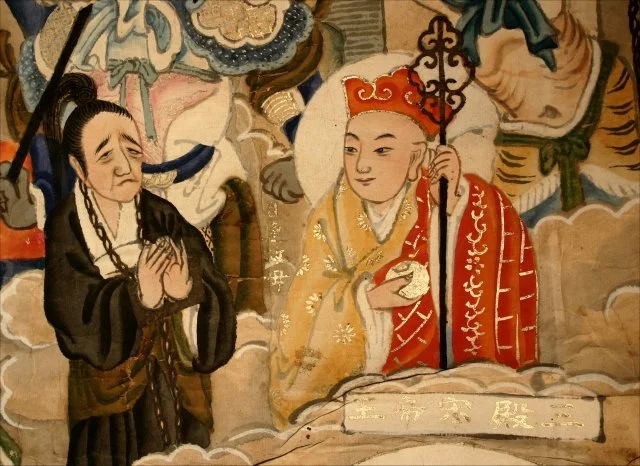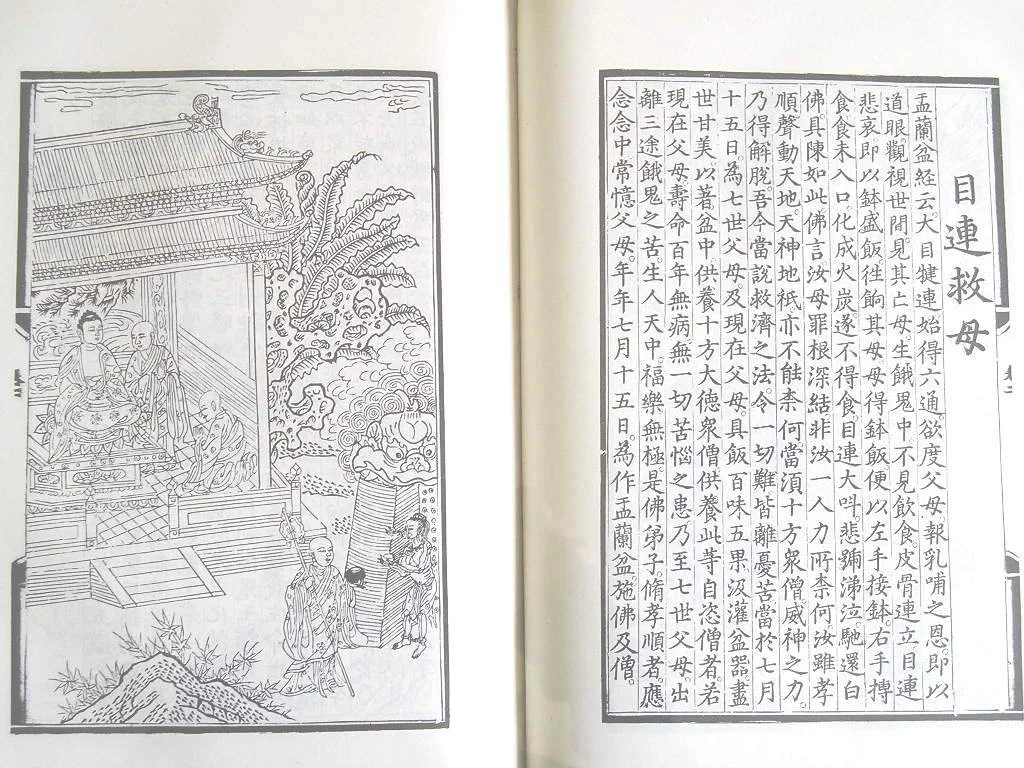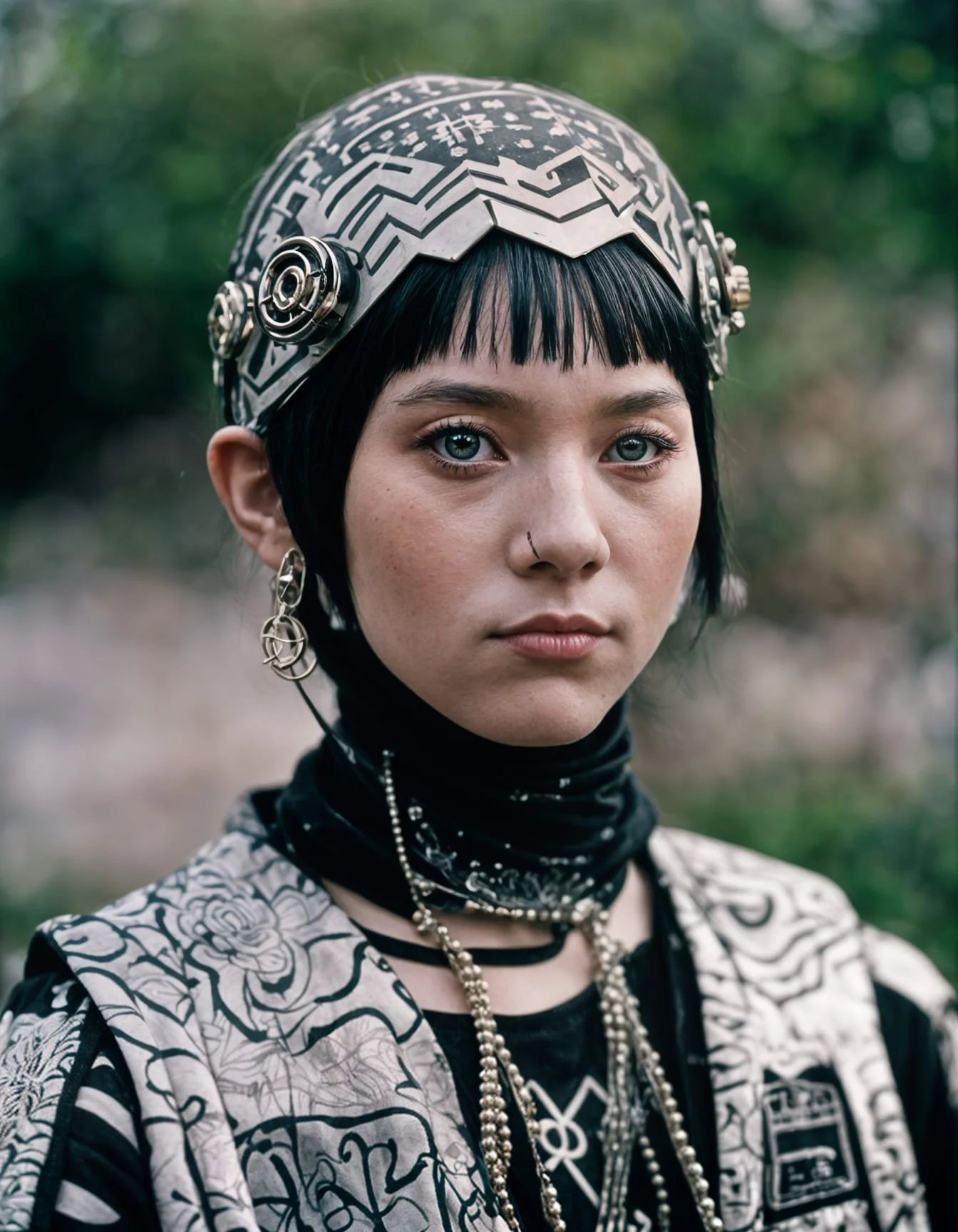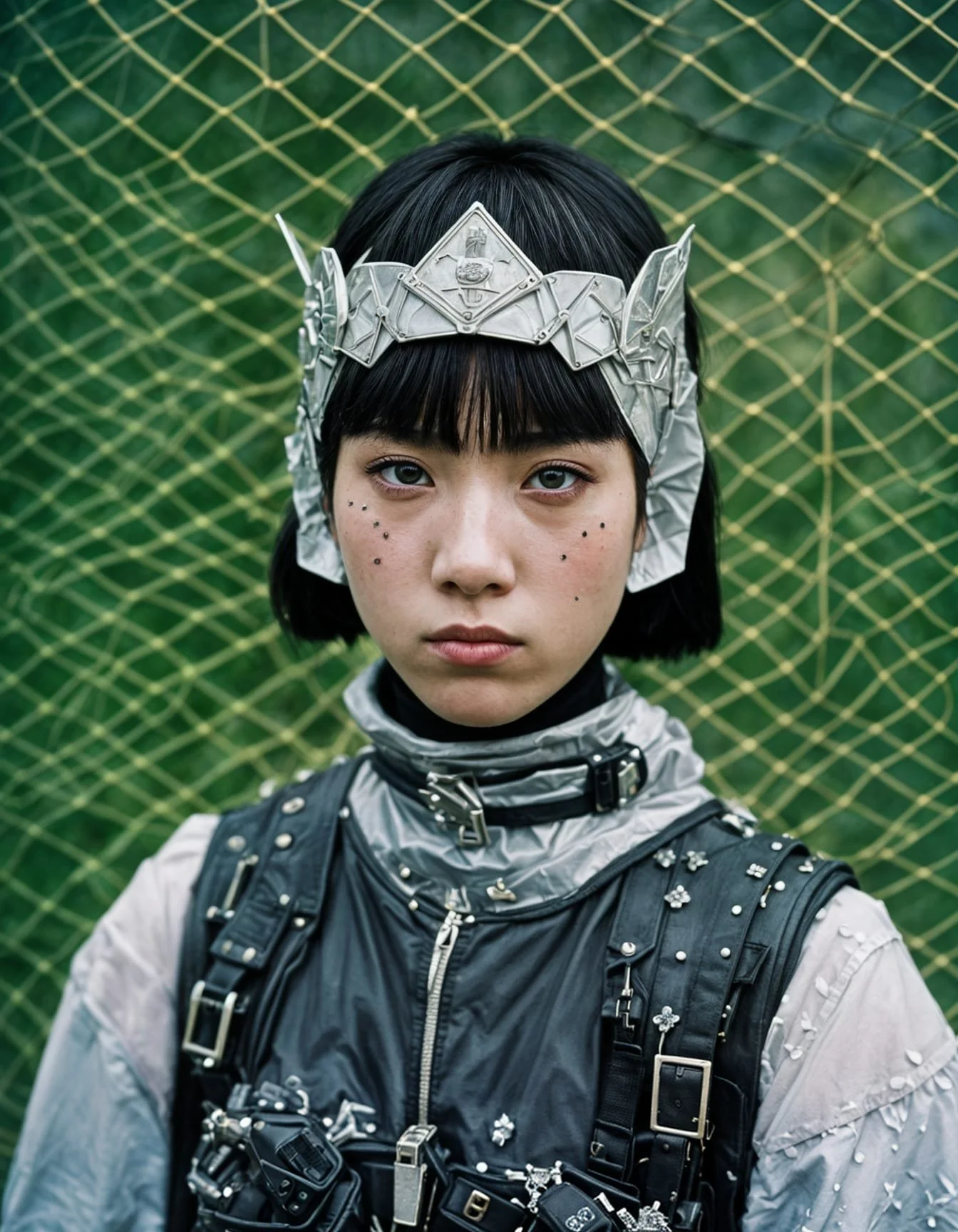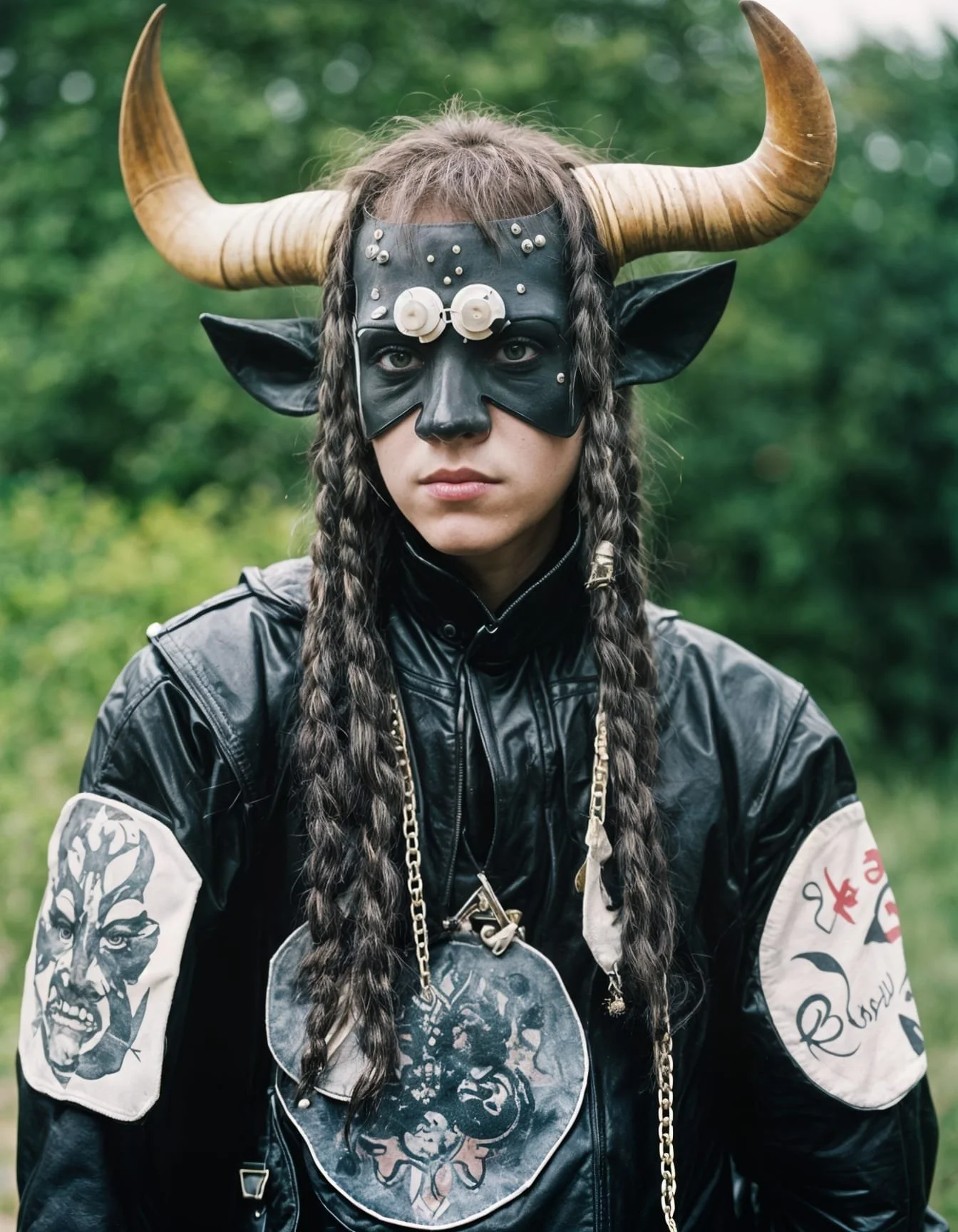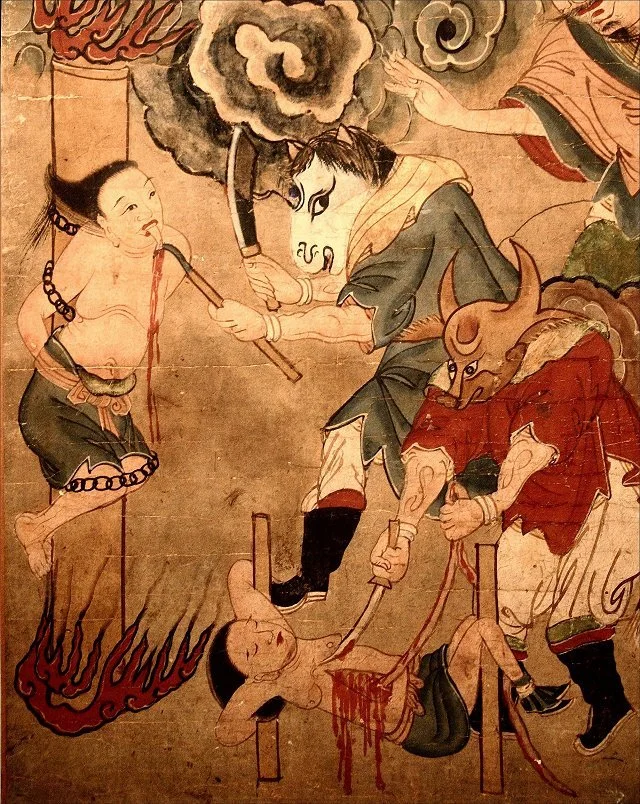Transmuted Souls: Reclaiming Identity in the Hungry Ghost Festival
Welcome, Voidpunks, to the next chapter of our identity creation journey. Inspired by our exploration of the Nine Songs, we now turn our focus to the transformative and powerful deities, demons, and guardians of the Hungry Ghost Festival. This guide, a companion to our upcoming workshop, is designed to help you connect with these extraordinary beings, transmute their energies, and forge a new persona—your very own Voidsona—that defies societal norms and celebrates the power of the misunderstood.
The Hungry Ghost Festival, or Zhongyuan Festival, is a time when the gates of the underworld open, and spirits roam the mortal realm. It’s a period of compassion and remembrance, but also one of immense power, rebellion, and transcendence. By embodying the fierce and multifaceted figures of this season, we can channel their strength to take charge of our own lives and be proud of our unique identities.
© Godong—Universal Images Group/Getty Images
The Filial Son and the Hungry Ghost
Mulian rescuing his mother, Madame Liu from hell (ancient scroll)
Mulian Intercedes With Buddha to Save His Mother.
A Note from the Photographer: Bridging Worlds with AI
As a neurodivergent artist with aphantasia – the inability to visualize mental imagery – the path from archival texts to the vibrant, contemporary visions of Voidpunk deities was a unique challenge. My imagination, while rich in concepts, often lacks the visual "eye." This is where AI became an indispensable collaborator, helping me bridge the gap between ancient archive and modern imagination.
After over 100 failed attempts with various Stable Diffusion workflows, I finally discovered the perfect technique: ControlNet Edge Mapping. By using canny edge detection to meticulously extract the ink outlines from traditional scroll images, I was able to give the AI precise instructions, allowing it to interpret and reimagine these characters as modern-day Voidpunks in Hong Kong. The images you see in this guide are the fruits of this intricate process – a fusion of ancient wisdom, personal neurodiversity, and cutting-edge technology.
Treat them as a MOOD BOARD for inspiration to help you create your own unique Voidsona.
Mulian (Maudgalyayana)
Mulian is the epitome of filial piety, but his journey is far from a simple tale. He is a powerful monk who descended into the deepest hells to save his mother. His story is about unwavering dedication and the ability to challenge even the most rigid of cosmic laws.
Qualities & Powers: Filial piety, persistence, spiritual power, and the ability to navigate different realms. He is a guide, a liberator, and a symbol of unconditional love that transcends death.
Visual Inspiration:
Colors: Saffron (for his monk's robes), deep crimson (for the hell he enters), and a shimmering, ethereal gold or white (representing his spiritual power).
Makeup: Minimalistic and clean, with a focus on a serene expression. Perhaps a small, glowing third eye painted on the forehead or subtle, light-reflecting pigments on the high points of the face.
Costume & Accessories: Simple, flowing robes made from textured linen or cotton. Accessories could include a staff adorned with skulls or bells, a glowing orb (representing the wish-fulfilling jewel), and prayer beads.
Madame Liu (Mulian’s Mother)
Madame Liu represents the suffering and karmic retribution of the hungry ghosts. She is a figure of desperate hunger and regret, a soul trapped by her past misdeeds. Her transformation, however, from a tormented spirit to a liberated one, is a testament to the power of salvation and forgiveness.
Qualities & Powers: Her power lies in her vulnerability and the chaos of her hunger. She is a symbol of rebellion against the fate of the damned, a spirit yearning for release.
Visual Inspiration:
Colors: Ash gray, charcoal, and muted browns. Hints of red or orange could represent the flames that turn her food into fire.
Makeup: Sunken cheeks and hollow eyes. Cracked or parched-looking skin with intricate, vein-like patterns. You can use face paint to create a gaunt, skeletal look.
Costume & Accessories: Tattered, layered fabrics with frayed edges. Textures should be rough and dry, like old burlap or worn-out cotton. Accessories could include chains, skeletal motifs, or a small, begging bowl.
The Rulers of the Underworld
Yama (Dharmaraja)
Yama, a Hindu god of death and justice, is a stern but fair figure. He is a lord of cosmic order, the one who judges souls and ensures that dharma is upheld. His power is in his absolute, unyielding authority.
Qualities & Powers: Justice, judgment, authority, and the personification of time and death. He is a figure of ultimate consequence, balancing the scales of good and evil.
Visual Inspiration:
Colors: Dark, commanding colors like deep indigo, black, and maroon. Gold accents can represent his royal status.
Makeup: A fierce, scowling expression. Bulging eyes and a long, dark beard. Face paint can be used to create sharp, angular lines to emphasize a stern countenance.
Costume & Accessories: Heavy, elaborate robes with intricate patterns. A judge's cap or a crown with a "king" character. His mount, a buffalo, can be represented by a stylized horned headdress or shoulder pads.
Yanluo Wang (The Ten Kings of Hell)
Yanluo Wang is the Chinese counterpart to Yama, overseeing the "Ten Kings of Hell." He is a central figure in the underworld bureaucracy, a supreme judge who determines the fate of souls. He represents the intricate, administrative side of the afterlife.
Qualities & Powers: Judgment, bureaucracy, and a deep understanding of human deeds. He is a master of records and a symbol of unshakeable justice.
Visual Inspiration:
Colors: Rich reds, blacks, and golds. The contrast of these colors can represent the power and wealth of the underworld.
Makeup: A stern, commanding look with a long, dark beard. You can add the Chinese character "王" (wáng, 'king') to his forehead with face paint.
Costume & Accessories: Ornate robes of silk and brocade. A judge's cap or crown. A large ledger or scroll (the Book of Life and Death) can be a powerful accessory.
Ox-Head and Horse-Face
Ox-Head and Horse-Face are the first faces a soul sees upon entering the underworld. These fierce guardians are not evil, but rather dutiful servants of Yanluo Wang, tasked with escorting the dead. They represent the unavoidable reality of death and the transition into the afterlife.
Qualities & Powers: Unwavering loyalty, strength, and the role of a psychopomp (guide of souls). They are the gatekeepers of the underworld.
Visual Inspiration:
Colors: Earthy tones like brown and gray for Ox-Head, and more sleek, dark colors for Horse-Face.
Makeup: Focus on the transformation. For Ox-Head, a bull-like snout and horns, with a rugged texture. For Horse-Face, a sleek, equine face with a flowing mane. You can use prosthetics or elaborate face paint.
Costume & Accessories: Simple, functional guard uniforms or armor. They can carry chains and tridents. Materials can be rough leather, heavy metal, and coarse fabrics.
The Celestial and the Terrestrial
Dragon Kings and Queens
The Dragon Kings are the rulers of the seas, masters of water, weather, and immense power. Their domain is vast and their temperament is both fierce and benevolent. They represent the wild, untamable power of nature and the deep secrets of the ocean.
Qualities & Powers: Control over water, weather, and natural forces. They are symbols of imperial power, wisdom, and transformation.
Visual Inspiration:
Colors: The four main Dragon Kings correspond to the four directions and their associated colors: East is Azure/Green, South is Red, West is White, and North is Black. Yellow is for the central dragon.
Makeup: Scaled patterns on the skin, intricate eyeliner, and iridescent pigments. Horns, beards, and whiskers are essential.
Costume & Accessories: Flowing, layered robes with scale-like textures (sequins, beaded fabrics). Crowns adorned with pearls, jade, and coral. Accessories can include tridents, fans, and flowing sashes.
Heibai Wuchang (Black and White Impermanence)
These are two deities who escort the souls of the dead. Heibai Wuchang represent the dualities of life and death, good and evil, and the unpredictable nature of fate. The White Guard is often friendly and gentle, while the Black Guard is stern and fierce.
Qualities & Powers: Duality, impermanence, and the role of a psychopomp. They are a reminder that life is fleeting and that all things are in constant change.
Visual Inspiration:
Colors: Stark black and white. You can use these colors in contrasting patterns or in a yin-yang style.
Makeup: The White Guard can have a friendly face with a long, white tongue sticking out. The Black Guard can have a menacing scowl and a long, black tongue.
Costume & Accessories: Traditional robes or constable uniforms. They often carry large, black and white hats and chains for escorting souls.
Kṣitigarbha
Kṣitigarbha, or Dizang Pusa, is a Bodhisattva who made a great vow to not achieve Buddhahood until all hells are emptied. He is the savior of hell-beings, a compassionate and powerful figure who brings light to the darkest places.
Qualities & Powers: Compassion, filial piety, and a great vow to save all beings. He is a beacon of hope in the underworld.
Visual Inspiration:
Colors: Earth tones (as his name means "Earth Womb"). Saffron for his robes, and a warm, glowing light from his aura.
Makeup: A serene, monk-like face with a halo effect.
Costume & Accessories: Simple monk's robes. A staff with six rings to open the gates of hell and a wish-fulfilling jewel to light the way.
Kali
Kali, a Hindu goddess of time, death, and destruction, is a fierce and complex deity. While not directly related to the Hungry Ghost Festival, her themes of death and transformation resonate deeply with the Voidpunk ethos. She is a raw and untamed force of nature.
Qualities & Powers: Destruction, empowerment, and time. She destroys evil forces and represents the cyclical nature of creation and destruction.
Visual Inspiration:
Colors: Blue or black skin, representing the vastness of the sky and ocean. Red for her tongue and blood.
Makeup: A ferocious expression with a long, red tongue hanging out. Use dark pigments for the skin and a third eye on the forehead.
Costume & Accessories: A garland of skulls and a skirt of dismembered arms. You can use body paint to create these illusions. She can carry a sword and a severed head. Her hair is long, black, and free-flowing.
Pre-Workshop Checklist
Choose Your Character: Select the deity or figure that resonates most with your personal journey.
Gather Materials: Collect makeup, fabrics, and accessories that align with your chosen character's qualities and powers.
Experiment with Your Look: Practice your makeup and costume, allowing your Voidsona to take shape.
Embrace the Power: Remember that this is more than just a costume; it's a way to channel power, defy expectations, and celebrate your fierce, authentic self.


